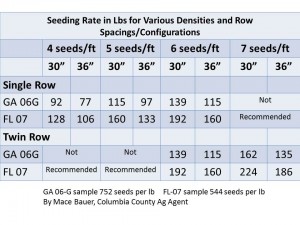Peanut seeding rates is an interesting topic. However, it becomes rather complicated because farmers often call other “good” farmers and get their recommendations. For example, I know one “good” farmer who routinely plants 90 lbs of seed per acre, and I know another “good” farmer that recommended using 205 lbs of seed per acre for some large seeded cultivars this season. I use “good” in this situation meaning that each of these farmers consistently averages above 4,500 lbs per acre and has yield goals over 5,000 lbs and make the needed management decisions to reach these goals. Obviously, we are dealing with several differences in this comparison. To complicate things, one is what I would call very conservative, compared to the other being a very aggressive manager. One is on single 38″ rows, another on twin 30″ rows. They are both planting the same cultivars, but seed from different shellers. I share this example because, coincidentally, an area farmer contacted several “good” farmers this week and received this range of recommendations. I’m not sure I simplified the situation for him, but I hope this post can clarify things a bit.
Dr. Scott Tubbs at the University of Georgia has done extensive work on peanut seeding rates, yield responses, and economics. I have attached the 2012 UGA Peanut Production Guide where Dr. Tubbs summarized much of his work beginning on Pg 35.
2012 UGA Peanut Production Guide
In Extension, it is our role not only to distribute that information, but to help farmers interpret the science and integrate it into their operation for maximum economic return. Although Dr. Tubbs work is rather complex, I have drawn this professional interpretation: For economic optimums, plant 4-5 seeds per foot on single rows or 6-7 seeds per foot on twin rows. Obviously our more conservative farmers will be at the low end, and more aggressive will plant higher rates.
Unfortunately, our peanut seed bags do not say the seeds per lb like a bag of soybeans or grain sorghum. We know there are differences in cultivars and seed size, but we don’t usually know what they are. After we planted the Columbia County Peanut Variety Trial I brought back samples to determine the number of seeds per lb. With the help of the Master Gardener Volunteers, we determined the Georgia 06-G we planted had 752 seeds per lb and the Florida-07 had 544 seeds per lb. For your additional info, FLO-107 had 736 seeds per lb, but I will not use those numbers in this analysis. Although our numbers may not match the seed you will receive on your farm, they are a good example of the variability one will encounter.
The final piece of this puzzle is row spacing and planter pattern. As mentioned, I routinely work with farmers on single and twin 30″, single and twin 36″, and single 38″ rows. However I know another area farm is on twin 40″, so all types of planters are out there and each will have different optimum seeding rates. For simplicity, I have built the following table of seeding rate in lbs per acre for the seed we used in the variety trial. This chart includes various planter configuration and desired number of seeds per foot.
My predecessor, Mr. William Thomas provided the following file that you may also be interested in. This table shows the pounds of seed per acre you will use at a desired number of seeds per foot. You will need to count the number of seeds per lb, but you might take a shortcut and count the number of seeds per 4 oz or 8 oz and get a pretty close approximation.
Peanut Seed Planting Table by William Thomas
Thank you and Happy Planting!


Good info, very helpful